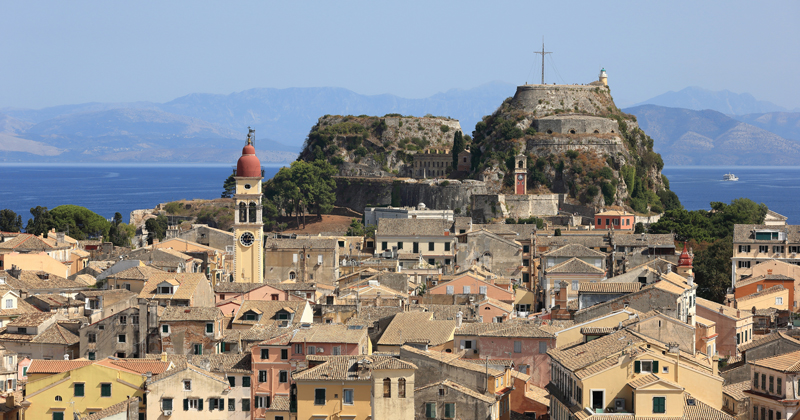World Heritage on the Greek Isles
Bleached white churches with sky-blue domes,

the Greek islands – whether they be Aegean, Cycladic, Dodecanese or Ionian – symbolize tranquility and romance. Its ancient temples, gods and goddesses, agoras, mosaics, and small villages embody escape.
While Greece includes 6,000 islands and islets scattered in the Aegean and Ionian Seas, only 227 are inhabited. The country is home to 18 UNESCO World Heritage sites, and six of them are located on islands: Chios, Corfu, Delos, Patmos, Rhodes and Samos. Among the designated sites are two well-preserved Old Towns, several monasteries and famous caves.
CHIOS
Greece’s fifth largest island in the Aegean, Chios, is home to a group of monasteries that have been designated UNESCO World Heritage sites – Daphni, Hossios Luckas and Nea Moni.
The 11th century Nea Moni is one of the most important ensembles of Byzantine mosaics in the Mediterranean, preserved in a museum housed in an old two-story cell that exhibits post Byzantine icons as well as religious and folk embroidery.
Worth exploring is the famous Mastihohória, a series of fortified villages built in the 14th century. Among them, Mesta is a medieval treasure with preserved castle towers, ancient churches and magnificent stone houses tightly joined together with arches.
Try local specialties cooked with mastic, or have a sip of soumáda, a traditional drink made of almonds.
Corfu
“The more I see from this place, the more I feel that no other spot on earth can be fuller of beauty,” wrote Edward Lear in 1863 to describe the island of Corfu. He wasn’t the only one… this is where the Venetians, the French and the British used to live, and where the Ottomans seem never to have set foot.
Of course Lear was not stepping off a modern cruise ship at high season, which actually leaves you in the port milling with backpackers on cheap charter flights in summer. To reach the most fetching part of town, take a taxi into the Old Town, which is the heart of the island.
By foot, you will discover the most beautiful spots in the city: Spianáda. The square is adorned with 19th-century French architecture; Listón’s arcades form a romantic background, making it a great resting spot for a cup of coffee at one of the town’s cafés.
Visit some of Corfu’s impressive museums, from The Museum of Asian Art that was founded in 1927, to the Dionysios Solomos Museum, formerly the home of the national Poet of Greece who lived in a state of self-imposed isolation here.
Delos
This, in a way, is where it all started, as it is the legendary birthplace of Apollo and Artemis, and used to be a religious center for the entire country in ancient times, as well as the foremost trading port in the Eastern Mediterranean during Roman times. Uninhabited today, Delos’ designation as a UNESCO World Heritage site draws thousands of visitors each year to admire its monuments and impressive mosaics.
Patmos
This small island owes much of its fame to St. John the Evangelist and to one of the most famous caves in the world – the Apokalipsi Cave.
St. John, who was exiled on Patmos in AD 95, wrote the Book of Revelations in this cave. A few rock-cut steps lead to the entrance of the cave. Once you arrive, climb down a few more steps to see the church of Agia Anna, which was renovated during the 17th century. A small settlement, called Hóra (Chora), started to develop around the monastery and the island grew to become the jewel of civilization in the archipelago.
Rhodes
Enter one of the largest and best-preserved medieval towns in Europe through the Gate of Freedom that leads to the Old Town of Rhodes, a mosaic of 24 centuries of different cultures. The bastions, walls, gates, narrow alleys, minarets, old houses, fountains, tranquil and busy squares are just the beginning.
The highlight is the Palace of the Grand Master that was originally a Byzantine citadel built at the end of the 7th century A.D. It was converted in the early 14th century by the Knights Hospitaller into the residence of the Grand Master of the order; it is now a museum.
Another must-see is the cobble-stoned Street of the Knights. Lined with medieval inns that used to host soldiers the road leads to the Knights Hospital, which now houses the Archaeological Museum.
SAMOS
Remember your high school geometry – particularly the Pythagorean triangle? This is the birthplace of the Greek mathematician Pythagoras, the philosopher Epicurus, and the astronomer Aristarchus of Samos, the first to propose that the earth revolved around the sun.
The big draw is the Temple of Heraion, traditionally known as Hera’s birthplace, a huge archaeological site that includes the 300-foot long, 75-foot tall and 150-feet wide temple, grand altar and the sacred road.
Besides its white-sand beaches, and traditional villages, Samos is famous for sweet wine.
Remember, after a long, hot day spent climbing over the ancient sites, there are always long sandy beaches and deserted coves waiting to be discovered in Greece. www.visitgreece.gr




